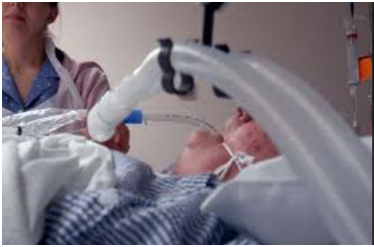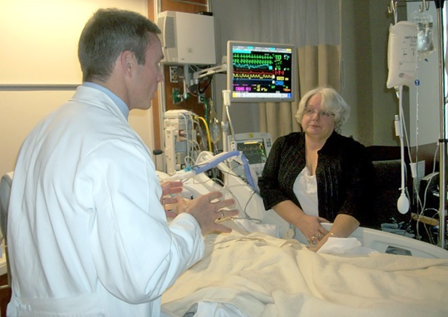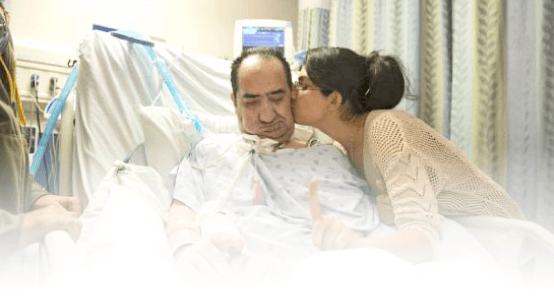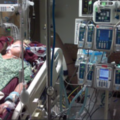Podcast: Play in new window | Download
Subscribe: Apple Podcasts | RSS
Hi, it’s Patrik Hutzel from INTENSIVECAREHOTLINE.COM where we instantly improve the lives for Families of critically ill Patients in Intensive Care, so that you can make informed decisions, have PEACE OF MIND, real power, real control and so that you can influence decision making fast, even if you’re not a doctor or a nurse in Intensive Care!
This is another episode of “YOUR QUESTIONS ANSWERED“ and in last week’s episode I answered another question from our readers and the question was
Why Do They Need to Put My Dad in an Induced Coma in the ICU?
You can check out last week’s question by clicking on the link here.
In this week’s episode of “YOUR QUESTIONS ANSWERED”, I am here with a live stream today, where I want to answer your questions if you have a loved one in intensive care. And this is one of the most commonly asked questions for families in intensive care and it’s a question that we get all the time. And today’s live stream is about 10 common problems coming off the ventilator in ICU and how to solve them! Live stream!
10 Common Problems Coming Off the Ventilator in ICU and How to Solve Them! Live stream!

Wherever you are, welcome to another intensivecarehotline.com live stream. And today’s topic is “10 Common Problems Coming Off the Ventilator in ICU and How to Solve Them.”
We get so many questions here at intensivecarehotline.com about how long it takes to come off the ventilator, and there are so many variables that I decided to do a livestream about this because I believe I can destroy some of the myths today and shed light on what’s really holding people back on coming off the ventilator in ICU.
Now, before we go into today’s topic, you might wonder what makes me qualified to talk about today’s topic. I’ve worked in intensive care as an intensive care nurse for over 20 years in three different countries. I have worked for over five years as a nurse unit manager in intensive care. I have been consulting and advocating for families in intensive care all around the world since 2013. I’m talking to families in intensive care every day of the week, all over the world.
And I’m also the founder of Intensive Care at Home where we provide intensive care services at home for predominantly long-term ventilated adults and children with tracheostomy, but also otherwise medically complex clients that otherwise would be in intensive care or potentially would have passed away if it wasn’t for our service because many ICUs want to empty their beds by literally letting people die and we give people options with Intensive Care at Home.
Now, coming back to today’s topic, if you have any questions regarding today’s topic, please type them into the chat pad or you can call in live on the show. I will give out the phone numbers after I’ve gone through my list of things that I want to discuss today, and then you can also call in live on the show. But if you have any other questions that are related to today’s topic, type them into the chat pad. If they’re not related to today’s topic, type them into the chat pad as well and I will get to them at the end of this presentation. So, let’s dive right into it.
RECOMMENDED:
So “10 Common Problems Coming Off the Ventilator in ICU and How to Solve Them”. So, whilst they are common problems that I’m going to talk about in a minute, it’s also often a combination of things that are happening. As you would’ve heard me saying over and over again when someone is in intensive care, there are dozens of things happening simultaneously and unless people understand that it’s like a puzzle that needs to be pieced together, it’s never black and white in intensive care, it’s always one thing linking to another, one thing leading to another. You can never look at things in isolation. And what I mean by that is I can probably illustrate that with the first common problem that keeps patients from getting off the ventilator in ICU.
The first common problem is clearly sedation and the induced coma, and that is clearly an obstacle for people to get off the ventilator. However, again, that cannot be seen in isolation either because why are people in the induced coma? What’s led to that? Is it fractures? Is it surgery? Is it pneumonia? Is it intoxication? Have people been intoxicated by alcohol, drugs, whatever the case may be? So, you can never look at this in isolation, but let’s just stick with that.
So obviously one of the most common issues of people not coming off the ventilator straight away is sedation. Sedation, broadly speaking are drugs like propofol and versed or midazolam. The two most commonly used drugs in ICU sedation again are propofol and midazolam. Propofol, short-acting, quick onset, people should wake up quickly once it comes off.
On the other hand, you’ve got a long-acting sedation such as midazolam or Versed. People don’t wake up quickly when it comes off or when it’s been taken away. It also has an addictive effect because it’s a benzodiazepine. So, the longer patients are on Versed in particular or midazolam, the higher chances they’re going through withdrawal, which is another issue of then not coming off the ventilator quickly. So, I need to categorize that in sedation as an issue.
Other sedatives that are used in ICU quite commonly now are Precedex, also known as dexmedetomidine, and also sometimes ketamine is used. But ketamine is more. It’s ketamine and Precedex are combination of sedatives and opiates.
So that leads me to the next issue of not coming off the ventilator, which is opiates. So, when you look at someone on a ventilator on a breathing tube or an endotracheal tube, they’re also often on morphine or fentanyl, and morphine or fentanyl are strong opiates. And strong opiates, again, are addictive in nature. Not only that, one of the main side effects of morphine or fentanyl is respiratory depression. So, what that means is someone on a ventilator with a goal of coming off the ventilator is having morphine or fentanyl or alfentanil or oxycodone, sometimes OxyContin IV, all of that, and yet those medications have respiratory depression as a side effect, counterintuitive to give drugs that have respiratory depression as a side effect.
If you have someone with a goal to get off that ventilator as quickly as possible, by the same token, the breathing tube or the endotracheal tube in the throat is so uncomfortable that patients can’t tolerate it without opiates. But the combination of, again, sedation, opiates is counter to wanting to achieve the goal of coming off the ventilator.
Similar to midazolam or Versed, morphine or fentanyl have addictive or are addictive medications by nature and they therefore potentially go through withdrawal. And that’s if someone is on a ventilator that needs to follow commands, needs to breathe, needs to cough, it’s prohibitive of getting off the ventilator.
So, it’s a necessary evil to use sedation and opiates, but it’s also counter to what people want to achieve. There are so many side effects from the induced coma, confusion, agitation. I’ll come to those issues later on my list, but just to illustrate that, that’s what I’m saying. As much as I go through them one by one, one ties in with the other. It’s not those sedatives themselves that will lead patients to stay on the ventilator. It’s a combination of issues. So, we’ve got that out of the way. Sedatives, opiates, addictive in nature, knocking people out.
If people are in liver failure or kidney failure and they’re on sedatives, again, that is a bad combination because what’s basically happening is if someone is in liver failure or kidney failure, they have high amounts of sedation or opiates, medications are not getting metabolized in the liver or in the kidney, not getting excreted in the kidneys, not getting metabolized in the liver. They stay in the system for longer delaying waking up, delaying getting off the ventilator. The goal if someone gets intubated in ICU or during surgery and ends up in ICU, whatever the case may be, the goal is keep them ventilated, wake and wean. That’s the well-known phrase in the ICU world that ideally a patient goes in ICU on a ventilator, wake and wean. Wake them up from the induced coma, wean them off the ventilator. That is the ideal scenario. But if you are here watching this video, you probably know that it’s a nice saying, but it’s often not straightforward. And we know in ICU that it’s not straightforward often.
So next, what else leads to people not coming off the ventilator in ICU? And I should also say I’m predominantly today talking about not coming off the ventilator with the breathing tube and an endotracheal tube. I have made other videos about when people don’t come off the ventilator with a tracheostomy, but today the focus is really on breathing tube and endotracheal tube.
Next, other issues that lead people to not coming off the ventilator are fractures. Fractures of any sort after motor vehicle accidents, after falls, you name it, that also stops people from coming off the ventilator. You have someone going into ICU with rib fractures, femur fractures, shin bone fractures, you name it, numerous fractures. Of course, traumatic brain injury, I’ve got them separate, but fractures are definitely an inhibitor, especially if they’re upper body rib cage, anything that could impact on the breathing.
But also, for example, if someone has a hip fracture, a femur fracture, whatever the case may be, they’re possibly waiting for surgery, and you wouldn’t necessarily try and extubate them before surgery. But then there’s also issues around fractures, you’ve got to control pain. That leads me back to opiates. If you’re giving them opiates, not only to tolerate the breathing tube, but if you’re giving them opiates to tolerate the pain, again, bad combination to get someone off the ventilator. But you can already see it’s all linked, it’s all intertwined. One issue leads to another, and one issue needs to be solved to solve another issue.
Next, open-heart surgery such as bypass grafts, valve replacements, valve repairs are also another issue of people coming off the ventilator. Now you heard me say before a minute ago the term, I used the term wake and wean. So, when someone goes into ICU after open heart surgery, they’re often on a clinical pathway. So, what that means is you’re following certain procedures after open heart surgery, you’re measuring drainage from the wound side, you’re trying to take away cardiac support such as inotropes, vasopressors, or vasodilators, you’re trying to stop pacing if people are paced. If they’re on a pacing machine, which they can be sometimes after open heart surgery, you try to wean all of that away and then you try to extubate them, take off sedation, take off opiates, and then you try to extubate them. And then ideally if they follow the pathway, they are going to the hospital ward or the floor ward the next day, one day ICU and they’re out if all is straightforward.
Well, not much is straightforward in ICU and especially if someone is having open heart surgery after cardiac arrest, heart attack, whatever the case may be, that’s also when patients might not be able to get extubated because there are complications after open heart surgery. You have got to picture this during open heart surgery, patients are on a bypass machine in theatre or in the operating room. If they’re on a bypass machine in the operating room, the lungs are collapsed. The lungs are collapsed, so the surgeon can get access to the heart during surgery. Okay. So, then the oxygen exchange happens on the bypass machine to take over the function of the lungs and the heart during surgery. And then after surgery, the lungs will get reinflated. But because the lungs have been deflated for a period of time, often two, three, four hours, there’s the risk for pneumonia and that is often a delay for extubation as well.
Other complications that can occur after cardiac surgery are irregular heart rhythms, bleeding, inotrope requirements, low cardiac output, low cardiac index, hypervolemia, and the list goes on. Cardiac surgery is high risk surgery, and if someone can be extubated within less than 24 hours and go on to a hospital floor day one after surgery, that is fantastic. That is fantastic.
So next, chest drains. So, talking about cardiac surgery and going on from there. When patients come out of cardiac surgery, they often have chest drains, but then anyone on a ventilator is at higher risk of having chest drains, and those chest drains can come again from cardiac surgery. They can also come from pleural effusions, from pneumothoraxes, and that can be an obstacle for extubation as well. Why? Because chest drains are incredibly uncomfortable. And again, patients with chest drains often need a high amount of pain relief, and again, often need opiates to manage the pain. Now, what are chest drains there for? They’re there to drain any excess fluids from the lungs, whether that’s pleural effusions, whether it’s post-surgery, blood accumulation, or whether it’s sometimes after pneumothorax to re-expand the lungs.
In any case, no matter what the reason is for chest drains or for a pleural drain, they’re very painful for the patients and they need to be pain controlled. And that could stop patients from getting extubated quickly as well. And often the drains need to come out first before a patient can be extubated. Now, I will say this, there are patients that can be extubated with a chest drain in situ, but it really depends on the situation.
Suggested links:
Next, pneumonia. Pneumonia is definitely an obstacle of coming off the ventilator, whether it’s aspiration pneumonia, whether it’s bacterial pneumonia, whether it’s a viral pneumonia, it can be an obstacle. If it’s bacterial pneumonia, you should give antibiotics for a few days. Hopefully, you can then, once the pneumonia is split, you can then extubate someone. But what sometimes happens is patients start out with viral pneumonia or with a bacterial pneumonia and they might then get a fungal pneumonia on top of that, or they might have a viral pneumonia and they might get a bacterial pneumonia on it or vice versa. That then delays people coming off the ventilator. Again, the solution to that is really trying to cure the pneumonia, trying to treat the pneumonia and then trying to extubate as quickly as possible.
Next, neurological issues such as traumatic brain injury, hypoxic brain injury, high ICPs (intracranial pressures), stroke, seizures, CSF (cerebrospinal fluid) leakages, CSF drainage through an EVD (external ventricular drain), brain bleeding. So, any neurological condition can be an issue around extubation. Okay, so that’s that. And especially with neurological conditions, a lot of it comes down to making assessments of the Glasgow Coma Scale. When someone is getting extubated, they need to be able to at least obey commands, obey simple commands such as squeezing hands on commands, opening eyes, making purposeful movements, and that can often not be achieved after neurological events such as, again, traumatic brain injury, hypoxic brain injuries, seizures, you got to picture this, someone on a ventilator needs to be sedated and in an induced coma, whether they have a brain injury or not. And as we’ve just discussed, waking them up is often not straightforward. So now you’ve got someone with an intact brain and waking them up is not straightforward. And now you have someone with a brain that’s not intact and you have the opiates and the sedation on top of that, waking them up is even more difficult.
Also, sometimes when people have stroke, seizures, hypoxic brain injuries, their seizures need to be managed with medications such as Keppra or phenytoin, also known as Dilantin, and those medications have a sedative effect as well. So, getting someone off a ventilator, especially with neurological conditions, the ones that I’ve just mentioned, seizures, hypoxic brain injury, traumatic brain injury, stroke with high intracranial pressures and so forth, or brain bleeding is very challenging to get people off the ventilator. What’s the solution?
The solution in those situations is often to proceed with a tracheostomy and then it’s easier to wean them off a ventilator depending on how severe the neurological deficits are. There is a chance that a tracheostomy needs to stay in for long periods of time, especially since patients with neurological conditions often can’t swallow properly, and if they can’t swallow properly, they are at high aspiration risk and therefore they need the tracheostomy.
Okay, next. So, we’ve covered all of that. Next, coming back to pneumonia, I should also talk about ARDS, especially during COVID. A lot of patients started out with COVID pneumonia and then it developed into COVID ARDS, but even before COVID, there were patients in ICU with ARDS. ARDS stands for acute respiratory distress syndrome, which the non-medical term is lung failure, okay. A very severe disease for patients in ICU. And when you look at the chest x-ray of ARDS patients, they’re completely whited out. And normally when you look at the chest x-ray, it should look black, which shows that the lungs are perfused, that there’s no infection, oxygen is going in, carbon dioxide is coming out. When you look at chest x-rays for ARDS patients, they’re often a complete white out, which means there’s no gas exchange taking place because it’s like a fibrotic picture where there’s so many secretions building up and the lung tissue is just blocked more or less.
So then often with ARDS (Acute respiratory distress syndrome), there’s two things happening. Patients are ventilated with high PEEP, high pressures, nitric oxide, epoprostenol, sometimes sildenafil, and then if that doesn’t work or if high frequency oscillation ventilation doesn’t work, you put a patient in prone position. That almost then doubles the need for sedation and opiates. And that’s not a good thing. And then patients also often need to be paralyzed with paralyzing agents so they can actually tolerate the prone position.
Now when that happens with proning, it takes patients even longer to wake up and it takes patients even longer to be weaned off the ventilator, even the ARDS might be cured, the pneumonia might be cured. Simply the more sedation, the more opiates, the longer the induced coma, the more paralyzing agents, the weaker the patients get, the more muscles there are wasted. The higher chances are that people do not wake up and can’t come off the ventilator quick enough. And again, the result of that is often a tracheostomy and it’s also a solution for it.
Now, if proning doesn’t work for ARDS patients, if the nitric oxide doesn’t work, if the epoprostenol doesn’t work, if the sildenafil doesn’t work, if high frequency oscillation ventilation doesn’t work, if proning doesn’t work, then the next step is ECMO. ECMO stands for extracorporeal membrane oxygenation. It takes over the function of the lung or the heart for a period of time, but it’s also an obstacle to being extubated because most of those patients need to be ventilated. And if patients are on ECMO, they need to come off ECMO first. And one of the indicators to come off ECMO, especially for lung failure, is that patients can get ready to get extubated.

So ECMO is an obstacle if the lungs can’t be cured. And ECMO needs to come off. How can ECMO come off if the lungs can’t be cured or if the heart can’t be cured? Well, one of the mechanisms to wean ECMO off for lung failure in particular is to do a lung transplant now and one of the other vehicles to wean ECMO off if ECMO was started for heart failure is a heart transplant. Now, of course, this is all not straightforward, but as you’ve heard me saying before, ICU is not straightforward. It’s never straightforward. It’s many pieces needing to fit into a puzzle. You need to understand the details and all the ins and outs.
Okay, so next, now let’s look a little bit more at mechanics and what do I mean by mechanics? So, when someone is on a ventilator, and especially when clients contact us here at intensivecarehotline.com, when clients contact us and say, “Hey, my loved one can’t come off the ventilator, what’s the reason for it?” And I know they’re breathing and they’re saying things like, I know they’re breathing on 40% or I know they’re breathing on 30%. And I go like, hang on a second, the devil is in the detail. We need to look at all ventilator settings and let’s look at that now. So, one of the main issues that patients can’t come off the ventilator if they’re on the ventilator still is low tidal volumes.
So, what do I mean by that? When someone is on a ventilator in ICU with a breathing tube, the ventilation mode before they can be extubated is usually CPAP (continuous positive airway pressure) or pressure support. And then you’ve got to watch for the tidal volumes. What that means is how big are the volumes when patients are breathing? So as a rule of thumb, the research suggests that it should be 7 to 10 mls per kilogram. If someone for simplicity weighs 70 kilos, one could argue it should be 700 mls maximum, it should be roughly 455 minimum. So that’s a good indicator in terms of how well someone is breathing. That also gets me to the minute volume. For example, the minute volume is the tidal volume x the breaths per minute. So, if someone is breathing 500 mls per breath, they are 70 kilos, x 15 is around 7.5 liters per minute. So, it is important that you can break this down. Again, the devil is in the detail.
So next, high PEEP. High PEEP is also an obstacle for extubation or for coming off the ventilator. The PEEP stands for positive end expiratory pressure. It’s the pressure that remains in the lungs and at the end of expiration when someone is on a ventilator so that the lungs don’t collapse. The higher the PEEP, the higher the chances someone needs to stay ventilated, the lower chances someone can be expedited PEEP, generally speaking, needs to be less than 7.5 cm of water.
Next is the pressure support. Again, when someone is breathing on CPAP or pressure support, the pressure support is the flow that supports the breaths, and the pressure support should be less than 10 or 8 cm of water. And again, PEEP and pressure support need to achieve a good tidal volume. Again, 7 – 10 mls per kilo, roughly per breath.
So, if all of those boxes are ticked, then you need to look at the arterial blood gas. So, what’s an arterial blood gas? An arterial blood gas is a blood test that’s taken from the artery of a patient, not from the veins. Big difference there. And then you’re running it through a blood gas machine. And the oxygen levels, also known as PO2 in the blood gas need to be a minimum of 60 millimeter per mercury. CO2 levels need to be 35 to 45 millimeters per mercury if that can be achieved. If pressure support is less than 10 or 8, if PEEP is less than 7.5, if tidal volumes are at least 7 to 10 mls per kilo per breath, if patient is awake purposefully moving hands, arms, makes purposeful movements, obeys commands, has a good cough, that in a nutshell ticks the boxes for someone to be taken off the ventilator. Take any of these things out, and it’s a high risk of taking someone off a ventilator.
Next. Secretions. Now, when secretions build up on the chest and patients can’t clear their airway, can’t cough up their secretions and need to be suctioned, that is another issue and another obstacle of coming off the ventilator. What’s the solution to that? The solution to that is potentially, again, going back in with regular suction, breathing exercises, coughing exercises, maybe using a saline nebulizer to loosen up the sputum, maybe using a bronchial lavage, maybe even doing a bronchoscopy to get rid of any secretions. And once that’s done, then again, that should be another obstacle taken or removed to taking someone off a ventilator.
But the question is, why are there secretions in the first place? Is it fluid buildup or are the secretions there because there’s an infection? If it’s an infection, the infection needs to be treated accordingly. Again, if it’s a bacterial infection, needs to be treated with antibiotics. If it’s a viral infection, it should be treated with antivirals. If it’s a fungal infection, it should be treated with antifungal medication.
So again, sometimes it’s also a case of fluid overload, okay? Because lungs, generally speaking should be kept dry when you want to wean someone of a ventilator. What that means is you have to watch your fluid balance. You have to watch how many fluids are going in, how many fluids are going out. The last thing you want is “wet lungs.” It’s the last thing you want for a ventilated patient.
Again, and you can probably quickly see when you suction someone, whether the sputum is yellow, which then means it’s an infection. If it’s white, it’s just sputum and you’ve got to weigh it up. Is it fluid overload? Next, how can you treat fluid overload? Potentially by fluid restriction or by giving diuretics such as furosemide or Lasix.
Next, what else can lead to another common problem that patients can’t come off the ventilator in ICU? Confusion, agitation, and aggression. How does that come about? Well, first off, when you wake up someone after an induced coma, they often have no recollection of what’s happened. They wake up in an ICU, they look at their surrounds. They might be confused because they’ve been in an induced coma, or they might be confused because they have a neurological condition. So, the best way to describe it is that patients feel very foggy at the best of times. So, if they’re confused, agitated, or aggressive, you also have to assess if are they going through ICU delirium or ICU psychosis as a side effect of all the medications they’re getting, as a side effect of having no day and night rhythm? And with that said, confusion, agitation, and aggression, are the patients going through withdrawal from some of the medications that we already spoke about, fentanyl, morphine, midazolam, or Versed? That could definitely lead to confusion, agitation, and aggression.
Recommended:
Did the patient again have a brain injury? Did they have low oxygen flow to the brain? That again, could also lead to confusion, agitation, and aggression. What’s the solution to this? Well, the solution to this is to potentially look at how to manage the withdrawal, and you could manage that potentially with some Precedex or some clonidine. But you could also manage if they’re withdrawing from drugs, alcohol. You could also look at alcoholics. I have seen in my early days in ICU people getting IV alcohol to manage the withdrawal. And it helped people get off the ventilator. If they’re withdrawing from drugs, do they need a little bit of methadone or whatever the case may be? But it could also be managed with anti-psychotic medication such as haloperidol, olanzapine, Seroquel. That could be another option to manage this issue.
Another issue that leads to not coming off the ventilator quick enough is simply no mobilization. Now, I am so frustrated when I talk to families in ICU that ICU tells them, well, it’s not safe to mobilize their loved ones. Well, that’s ridiculous. As long as someone is not on inotropes, or vasopressors, someone is hemodynamically stable, but they are ventilated, nothing should stop them from being mobilized in a tilt chair. I’m not talking about mobilizing patients like walking them around the unit. But even if that is happening, there is a unit in Colorado in the U.S. that’s doing that, and I have recorded a podcast with a lady that’s one of the nurse practitioners there. Her name is Kali Dayton. If you look on our podcast section, I have recorded the podcast with Kali where she talks about her experience in that unit where they’re mobilizing patients, even walking them around as quickly as possible to extubate patients as quickly as possible.
And they seem to have very good outcomes. But even mobilizing someone who is in a chair, you may think that’s not possible. Well, I can assure you it is possible. Right mindset, right staffing numbers, a can-do attitude and it can all be done, and patients will have shorter periods of time on the ventilator. I can guarantee you that. Now obviously you’ve got to weigh up again, can you mobilize someone with fractures? Can you mobilize someone after open heart surgery? But even that I’ve seen, especially after open heart surgery, that you can mobilize patients as quickly as possible.
Next, airway swelling is also an obstacle. Now, before I go into airway swelling, I have listed way more than 10 issues now, but there’s so many things that are standing in the way of someone coming off a ventilator, and I think it’s important that I list each one of them and I’m slowly approaching the end, and then it’s time for you to ask questions. So, airway swelling, sometimes the airway is swelling, and even though someone is displaying all the signs to be weaned off a ventilator, i.e, their tidal volumes are good, their blood gases are good, they’re obeying commands, they’re opening eyes, they’re coughing. And that’s a bit of a fallacy because if you then take out the breathing tube and the airway is swollen, the airway might block and then you might not be able to get a breathing tube back in. Very dangerous, very dangerous.
So how can you find out that there is no airway swelling? That’s number 1. And if there is airway swelling, how can you treat it? Well, you can find out if there is no airway swelling by taking the balloon down of the breathing tube. If you do that, if there is airway swelling, well nothing’s going to change. There’s no leak.
If you take the balloon down and there is no airway swelling, there is a leak which also makes it safe and to take the breathing tube out. But if there’s no leak, it means the airway is swollen. And if you take out the breathing tube, you could injure the windpipe, the trachea, and even worse, you could have a collapsed airway after you take the breathing tube out, and the only way to get to re-ventilate the patient would be with a tracheostomy. That would be an emergency tracheostomy, very dangerous. So, you’ve got to do those checks. How can you treat it? You can treat it with steroids, you can treat it with adrenaline or epinephrine nebulizers for the swelling to go down, but that can often take a few days. And it sometimes leads to a tracheostomy.
Next, pulmonary edema. I talked about secretions earlier, but one obstacle for someone coming off the ventilator is clearly water on the lungs, also known as pulmonary edema. Again, it is very important in ICU that you keep the lungs dry. The last thing you want for someone on a ventilator is have wet lungs by them being fluid overloaded.
Now sometimes what can lead to intubation as well is a cardiac condition, a heart condition such as heart attack, cardiac arrest, and if you’re fluid overload the lungs, you might have a fluid overloaded heart that’s weak and you’ve got to keep a patient dry, maximum 500 mls positive depending on the weight a little bit, and you’ve got to keep a very tight eye on the fluid balance and manage it very tightly. And how can you manage that? You can manage it? (A) by putting patients on the fluid restrictions and (B) you can give diuretics such as Lasix or furosemide. I talked about rib fractures, but again, rib fractures in particular are a big obstacle to someone coming off the ventilator.
What’s important there really is if someone has rib fractures, what’s best is trying to avoid intubating them in the first place, putting them maybe on an epidural or to manage pain so that you can ideally avoid intubation. Because trying to wean someone off a ventilator while they have rib fractures can be a big challenge. So, if you can manage it with an epidural or with a spinal block, that would be best.
Next, lung transplants can be an obstacle, especially if you have someone with pulmonary fibrosis, even though they might get a lung transplant, they’re not used to breathing. Sometimes it’s a bit of a fallacy getting someone a new set of lungs after they have pulmonary fibrosis and they’ve been struggling to breathe for so many years often, and for them there’s a huge psychological shift that needs to take place that all of a sudden, they are able to breathe. They often can’t believe it. I’ve seen that sometimes they can’t believe it, and that’s an issue as well. I did briefly mention in the beginning that liver failure and kidney failure can be an obstacle to coming off the ventilator as well. It ties right in with fluid overload. If someone has kidney failure and you’re not monitoring their fluid balance, that could be an absolute way in order for a patient to develop pulmonary edema. That’s one thing.
Also, if someone has liver failure, sedatives or opiates might not get metabolized as quickly as possible. They stay in the body system and delay waking up and then they’re delaying getting extubated. It’s the same with kidney failure. If sedatives and opiates are not getting excreted quick enough, that also delays waking up and then coming off a ventilator. And that pretty much concludes initially the 10 common problems coming off the ventilator, and I see it probably was probably 25 rather. But I hope you’ve got some value out of this, and I just thought I needed to cover all of them because as you can see, it’s such a complex area that the devil is in the detail, and that’s what I wanted to educate you on today in the details.

Now, Tara. Tara, welcome to the show. Tara says, “My mother had pneumonia and they kept her on one. They kept her on it. Hang on. My mother had pneumonia and they kept her on one, they kept her on it for about 21 days. When they removed it, she struggled to breathe for 24 hours, struggled to breathe and had her on very high oxygen. They also said they had her kidneys and liver shut down. Thank you for all the information”. So, Tara, I need more information there.
When you say my mother had pneumonia and they put her on one. What do you mean by that? One sedative, one… Please, you need to be more precise there please. I don’t know what you mean by that. On one, do you mean they put her on the ventilator for 21 days? I think that’s probably what it is.
So, I assume you are saying, my mother had pneumonia. They put her on a ventilator. They kept her on it for about 21 days. When they removed it, she struggled to breathe for 24 hours, and they had her on very high oxygen. They also said that her kidneys and liver shut down. They put her in a ventilator. Okay, okay.
It’s probably one thing that I didn’t mention as part of my 10 things is muscle wastage. So, there’s some research out there that suggests that every day someone is in an induced coma, they’re losing X percent of muscles. Now, I don’t know the exact number, but I’m not surprised, Tara, that your mother couldn’t breathe when they took her off the ventilator because her breathing muscles would’ve been so weak that she would’ve simply struggled after 21 days. So, it’s almost a case of people needing, after ICU, they need to learn to breathe again, they need to learn to walk again, they need to learn to eat again. It’s terrible. The side effects from an ICU stay are just terrible. And I’m not surprised by what I’m hearing there, Tara. Not at all.
Is your mom better now? And when the kidneys and liver shut down, why is that? So, the kidneys in particular, when patients are in ICU in an induced coma, often the kidneys do shut down for a number of reasons. One of the main reasons is that patients are often hypotensive, i.e, they have low blood pressure while they’re in the induced coma, and therefore the kidneys are not getting perfused enough, and that’s when we see kidney failure. Liver failure. I can’t comment on why that happened. It could be simply that she had too many sedatives and opiates and all sorts of other medications simply impacting on liver function. But there could be more to that. I couldn’t tell you that without having more information.
Now, if you have other questions, please type them into the chat pad. If not, you can also call into the show now. I’ve got another 20 minutes left. If someone wants to call in on the show now and ask questions live on the show, I’ve got Tara with another question here. “They said that the best thing we could do is let her go when they took the mask off”. Oh, hang on, pressed the wrong button. “When they took the mask off, she ended up passing away within about two minutes”. Oh, that’s terrible. So, your mom has passed away. I’m so sorry to hear that.
So then that would’ve been a one-way extubation. Were you expecting your mom to pass away as part of the extubation? Why did she not have a tracheostomy? Can you share more there?
In the meantime, while I’m waiting for Tara to get back to me, if you want to call in live on… “This was in March”. Yeah, sure. But Tara, did you expect that your mother would pass away when they were removing the breathing tube? Because then it would’ve been what’s referred to as a “one-way extubation.” Anyway, “No, my stepdad made the decision without me”. So, it was almost like a planned end of life decision. That’s what it sounds like to me.
In the meantime, if you want to call in live on the show and if you have questions, if you’re in Australia, please call 041 094 2230. That is again for our viewers in Australia, 041 094 2230. If you are in the U.S., please call 415 915 0090. If you are in the U.S. and Canada, please call 415 915 0090. And if you are in the U.K., you can call 0118 324 3018. That is again for our U.K. audience, 0118 324 3018. I’ve got about another 20 minutes to answer your questions either here by typing them in or you can call now live on the show.
So yes, muscle wastage is another big one, but again, it ties in with everything else. If people are in an induced coma, if people are sedated, as you’ve heard me say before, respiratory depression is one of the main side effects of opiates. Well, there goes muscle wastage goes hand in hand with that. So, people can’t really breathe when they come off the ventilator. It’s not a surprise. That’s why they need to get mobilized earlier. As I mentioned earlier, mobilization as early as possible, physical therapy or physiotherapy as quickly as possible, test physio as quickly as possible and mobilization, and only then can you restart strengthening the breathing muscles because otherwise this is exactly what’s happening then. Patients are potentially dying when you take them off the ventilator because their muscles have gone.
So, any other questions? I can see there’s still quite a few people here typing your questions in the chat pad, or again, you can call in. I’ll repeat the numbers one more time. Australia 041 094 2230, U.S., 415 915 0090. U.K. 0118 324 3018. If there are no other questions, that’s fine too. I will be back again next Saturday night, 8:30 PM Eastern Standard Time, which is Sunday, 10:30 AM Sydney, Melbourne time in Australia. I believe it is at 1:30 AM U.K. on a Sunday.
Now, if you have a loved one in intensive care, go to intensivecarehotline.com. Call us on one of the numbers on the top of our website or send us an email to [email protected]. I do offer one-to-one consulting and advocacy for families in intensive care. Please also check out our membership at intensivecaresupport.org.
Suggested links:
Patrik: Hi Helene, how are you?
Helene: I’m okay, Patrik. How are you?
Patrik: Very good, thank you. Nice to talk to you again.
Helene: Thank you. This segment has been amazingly insightful for me. It really checked a lot of boxes, and I’m going to definitely listen to this segment again, but one of the questions I have when you were talking about the excessive fluid overload, what is the procedure when they have to stick, it’s like a needle in the lungs to drain it?
Patrik: Yeah.
Helene: Drain it.
Patrik: Yeah.
Helene: What is that called?
Patrik: Yeah, it’s called a chest drain generally speaking, I don’t know whether it was something that I mentioned early in the presentation where I said a chest drain or a pleural drain can be used to drain excess fluids.
Helene: Okay. They used another term here in America, and I just have to Google it and then I’ll check, well, I’ll send it on one of your, I’ll send it to you some kind of way.
Patrik: Do you know what it was for? Was it for a pleural effusion? Do you know?
Helene: That could have been the word. Yeah, that may have been the word. Say that again.
Patrik: A pleural effusion.
Helene: No, that may have been it, that could have been the word, the term, but the question I wanted to ask you. That happened to my mom many, many times, unfortunately throughout the years, and it was done intentionally so they can do extra procedures to make more money. So, I remember when it first happened to her, she ended up on a ventilator. She had to discharge to an LTAC, and that’s where they said she needed to have the fluid drain off her lung. When the person who did this procedure, she drained a gallon and a half of green fluid off my mother’s lungs.
Patrik: Wow.
Helene: Now, with that being said, with that being said, the hospital that she had all these injuries that they caused and covered up, they were trying to wean her off the vent, but with that much fluid on the lungs, wouldn’t that be impossible for-
Patrik: I’d say so.
Helene: … weaned off the vent?
Patrik: I’d say so. I’d say so. It’s almost as if you’re telling me she’s pouring out, she was pouring out whatever volume you mentioned. So, picture this, if someone has fluid accumulation like a pleural effusion, which is basically at the periphery of the lung or at the peripheries of the lungs in the rib cage, the lungs can’t expand.
Helene: Yeah.
Patrik: And like you said, it’s nearly impossible to wean someone off a ventilator if that’s not taken care of. The question is why did she have so much fluid accumulation?
Helene:Because they intentionally gave her excessive fluid alone so they can get her on the vent so they can charge Medicare more money. She was a victim of medical exploitation.
Patrik: Wow.
Helene: Yeah. She ended up getting ARDS and you are the first person who ever explained what ARDS was to me as far as using the term lung failure. And my question on that is once one gets ARDS, is that permanent?
Patrik: No. There are patients that have been cured from ARDS, but ARDS has a high mortality in ICU. It’s one of the highest mortalities in ICU. I think the mortality is around 40 to 50%. If you looked through COVID and I don’t think that all the COVID statistics are out yet, but the most patients in ICU that died of COVID would’ve died of COVID ARDS.
Helene: Yeah. And she had pneumonia while she was at the first hospital. They concealed that from me, and once I saw all that fluid, that mucus that was drained off her lungs, it was green, which is a sign of infection. The other thing is too, when she drained, the person who did the procedure, when she drained it from mom’s lungs, she said she purposefully left a little bit in there in the lungs, and it was actually left on. It was left on the left side of the lungs in the lower part, and over time period, over some years it became just a mass. Have you ever heard of that type of situation before?
Patrik: Of a mass, like a cancerous mass or?
Helene: Yeah, it looked like it was cancer, but it wasn’t, was just think about meat-
Patrik: Sure.
Helene: … let’s say if I had a steak and I just kept it in water, you know how it look-
Patrik: Yeah.
Helene: Now, this happened to her originally in October of 2012, but when in 2016 she was at a different hospital by diversion, and that’s where it was really egregious medical being exploded and tortured and everything else. They tried to say it was cancer, and I’m like, no, no, my mother does not have cancer because she was under the care of a pulmonologist. However, he was not educating me and giving me the truth because he knew that he would be exposing malpractice that happened at the offset of it in 2012. So, he kept me in the dark as well as the ARDS, and he was a pulmonologist and all he would say as far as the ARDS was, make sure she has a good cough, but never explained it to me what ARDS was, and didn’t even tell me really about ARDS. I found out about ARDS from my chart.
Everything was… I had to find out on pretty much my own or by accident. So back with the mass, if fluid is left in the lungs, wouldn’t that also be a problem? Doesn’t it make the ARDS even worse?
Patrik: 100%. What often happens with ARDS is, I’d say I would’ve seen very few ARDS patients that didn’t have chest draining because of pleural effusions. Most ARDS patients at one point or another end up with chest drains.
Helene: Well, the only time they would give it to her is when she would be in the hospital, and they get very excessive fluid overload. I saw this as the pattern at multiple hospitals, and she was, that’s the most I can say about it. But I’m going to get off this case. Somebody else wants to ask you. Of course, want to call in.
Patrik: Yeah.
Helene: Thank you, Patrik.
Patrik: Thank you. Thank you so much. Thank you. Bye-bye.
Helene: Okay. Bye-Bye.
Patrik: Bye. All right.
Well, thanks Helene for contributing.
RECOMMENDED:
Please type any other questions into your chat pad or you can call in again, Australia, 041 094 2230. U.S., 415 915 0090. U.K., 0118 324 3018.
Now, you may also want to check out our membership for families in intensive care at intensivecaresupport.org. We can answer your questions there. As well as part of our membership, I would appreciate if you give this video a thumbs up, a like if you subscribe to my YouTube channel, if you share this video with your friends and families, if you click the notification bell and of course, comment below or you can comment now, and I can answer your questions while I’m still here.
Now, I can also give you next week’s topic, same time next week. Next week’s topic is “10 Things that a Good ICU Will Do”. So, 10 signs to look for within a good ICU. That’ll be the topic next week.
And if there are no other questions, then I will wrap this up for today.
I want to thank you very much for your support, and I will talk to you next week in this forum. Again, give it a thumbs up and subscribe to my YouTube channel.
Take care for now. Have a wonderful rest of the weekend.
How can you become the best advocate for your critically ill loved one, make informed decisions, get peace of mind, control, power and influence quickly, whilst your loved one is critically ill in Intensive Care?
You get to that all important feeling of making informed decisions, get PEACE OF MIND, CONTROL, POWER AND INFLUENCE when you download your FREE “INSTANT IMPACT” report NOW by entering your email below!
In Your FREE “INSTANT IMPACT” report you’ll learn quickly how to make informed decisions, get PEACE OF MIND, real power and real control and how you can influence decision making fast, whilst your loved one is critically ill in Intensive Care! Your FREE “INSTANT IMPACT” Report gives you in-depth insight that you must know whilst your loved one is critically ill or is even dying in Intensive Care!
Sign up and download your FREE “INSTANT IMPACT” REPORT now by entering your email below! In your FREE “INSTANT IMPACT” REPORT you’ll learn how to speak the “secret” Intensive Care language so that the doctors and the nurses know straight away that you are an insider and that you know and understand what’s really happening in Intensive Care! In your FREE report you’ll also discover
- How to ask the doctors and the nurses the right questions
- Discover the many competing interests in Intensive Care and how your critically ill loved one’s treatment may depend on those competing interests
- How to Eliminate fear, frustration, stress, struggle and vulnerability even if your loved one is dying
- 5 mind blowing tips & strategies helping you to get on the right path to making informed decisions, get PEACE OF MIND, control, power and influence in your situation
- You’ll get real world examples that you can easily adapt to you and your critically ill loved one’s situation
- How to stop being intimidated by the Intensive Care team and how you will be seen as equals
- You’ll get crucial ‘behind the scenes’ insight so that you know and understand what is really happening in Intensive Care
- How you need to manage doctors and nurses in Intensive Care (it’s not what you think)
Thank you for tuning into this week’s YOUR QUESTIONS ANSWERED episode and I’ll see you again in another update next week!
Make sure you also check out our “blog” section for more tips and strategies or send me an email to [email protected] with your questions!
Also, have a look at our membership site INTENSIVECARESUPPORT.ORG for families of critically ill Patients in Intensive Care here.
Or you can call us! Find phone numbers on our contact tab.
If you want a medical record review, please click on the link here.
Also check out our Ebook section where you get more Ebooks, Videos and Audio recordings and where you can also get 1:1 counselling/consulting with me via Skype, over the phone or via email by clicking on the products tab!
This is Patrik Hutzel from INTENSIVECAREHOTLINE.COM and I’ll see you again next week with another update!







